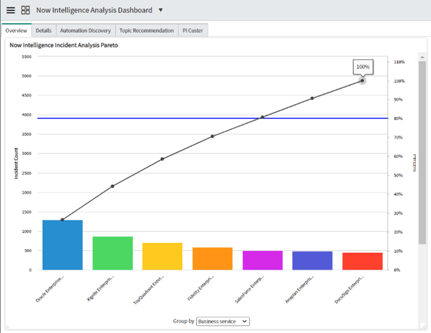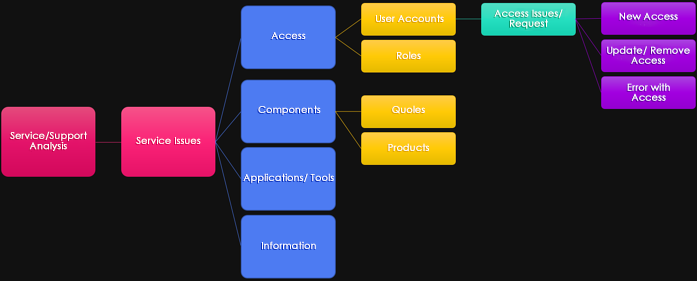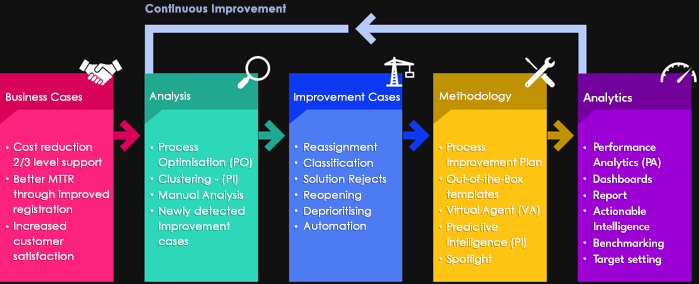HFS Research Podcast: The Next Wave with Bill...
Bill McDermott (Chairman and CEO of ServiceNow) and Ravi Kumar (CEO of Cognizant) join HFS Research Chief Analyst Phil Fersht to explore how AI is revolutionising enterprise...
Read MoreThirdera generates transformation, digitisation, and automation for our customers at the speed of NOW.
We help organisations adopt better patterns of work and get more from ServiceNow. Our team unlocks enterprise potential to elevate experiences across the world of work.
We help organisations adopt better patterns of work and get more from ServiceNow. Our team unlocks enterprise potential to elevate experiences across the world of work.
We help organisations adopt better patterns of work and get more from ServiceNow. Our team unlocks enterprise potential to elevate experiences across the world of work.
We help organisations adopt better patterns of work and get more from ServiceNow. Our team unlocks enterprise potential to elevate experiences across the world of work.
We help organisations adopt better patterns of work and get more from ServiceNow. Our team unlocks enterprise potential to elevate experiences across the world of work.
We help organisations adopt better patterns of work and get more from ServiceNow. Our team unlocks enterprise potential to elevate experiences across the world of work.
We help organisations adopt better patterns of work and get more from ServiceNow. Our team unlocks enterprise potential to elevate experiences across the world of work.
We help organisations adopt better patterns of work and get more from ServiceNow. Our team unlocks enterprise potential to elevate experiences across the world of work.

.jpg?width=500&height=276&name=filter%20group%20of%20people%20at%20desk%20laptop%20laughing%202021-10%20(1).jpg)


Insurance Provider Projects $75MM Gain in Business Value from Asset Management Transformation
Read more-1.jpeg?width=500&height=276&name=Indiana%20Department%20of%20Transportation%20Case%20Study%202023-03%20(3)-1.jpeg)
.jpg?width=500&height=276&name=Multichannel%20pipette%20tips%20reaction%20mixture%20plastic%20wells%202022-05%20(1).jpg)
.jpg?width=500&height=276&name=group%20-%20statistical%20analysis%202023-03%20yellow%20pink%20(1).jpg)
Balancing mission-driven goals with operational efficiency requires innovative solutions that can streamline processes and enhance programme delivery without straining budgets.

UN Agencies Rely on Thirdera and ServiceNow to Support the Ukrainian Aid Response
Read moreDigitise and automate workflows to enhance the customer experience, online and in-store.

.jpg?width=500&height=276&name=Servers%20data%20center%20room%20with%20bright%20speed%20light%202022-05%20(3).jpg)
Global SAP on Cloud Leader, Lemongrass, Embarks on Multi-Continent ITSM Overhaul
Read more

Stay up to date with the insights from ServiceNow experts and explore our blogs, news, case studies culture posts, partner updates and more.
Stay up to date with the insights from ServiceNow experts and explore our blogs, news, case studies culture posts, partner updates and more.
.png?width=500&height=276&name=MicrosoftTeams-image%20(638).png)
Stay up to date with the insights from ServiceNow experts and explore our blogs, news, case studies culture posts, partner updates and more.
.png?width=500&height=276&name=MicrosoftTeams-image%20(638).png)
Stay up to date with the insights from ServiceNow experts and explore our blogs, news, case studies culture posts, partner updates and more.
.png?width=500&height=276&name=MicrosoftTeams-image%20(638).png)
Stay up to date with the insights from ServiceNow experts and explore our blogs, news, case studies culture posts, partner updates and more.
.png?width=500&height=276&name=MicrosoftTeams-image%20(638).png)
Stay up to date with the insights from ServiceNow experts and explore our blogs, news, case studies culture posts, partner updates and more.
.png?width=500&height=276&name=MicrosoftTeams-image%20(638).png)
Stay up to date with the insights from ServiceNow experts and explore our blogs, news, case studies culture posts, partner updates and more.
.png?width=500&height=276&name=MicrosoftTeams-image%20(638).png)

The long-awaited opportunity to make use of Artificial Intelligence (AI) and Machine Learning (ML) to drive down costs and improve customer experience in the Service Delivery world is finally here. For ServiceNow clients that have licensed ITSM Pro, that opportunity lies in the Now Intelligence suite of solutions which include Virtual Agent (VA), Predictive Intelligence (PI), and Performance Analytics (PA).
This blog by Pedro Soto, a guest contributor and a Now Intelligence Practice Lead with Thirdera's Partner Westbury Analytics, reveals 3 little-known secrets to demystify how to achieve success in your Virtual Agent implementation.
True AI and ML are finally here on the Now Platform. ServiceNow has enabled these technologies in such a way that you no longer require a background in data science in order to implement them. That’s good news. As well, making those solutions work to deliver on their promise is a straightforward process that any technical person can learn quickly.
However, what is not so straightforward is how to pull together all the different pieces that go into making VA deliver its value. Complicating this challenge is the fact that implementing an AI-driven chatbot is not like implementing ITSM technologies which most IT pros have delivered throughout their careers.
There is one (and only one) objective that must be accomplished for VA to be successful in any organisation; user adoption. The mere availability of AI, ML, and the VA solution does not automatically ensure that users will adopt your VA implementation.
The experience that is delivered through the VA is the ultimate determinant of user adoption. Here is a proven approach to getting it right.
First, it is useful to think of 3 levels of integration between VA and your service delivery process that must be achieved.
Level 1 addresses the ability for users to open incidents, submit catalog requests, and manage the lifecycle of all the tickets they submit. This is the easiest and most basic part of the VA implementation. It can be accomplished very quickly using the out-of-the-box functionality that comes with VA.
Depending on your service delivery environment, any adjustments you require should be minor. The goal here is to start migrating your user community to the VA channel using familiar activities, like submitting incidents and requests similar to previous channels, with a very low risk of having a bad experience.

Level 2 relates to the development of custom topics. When properly created, this can present the potential for an increased positive user experience while simultaneously improving mean-time-to-resolution (MTTR), first call resolution (FCR), and overall costs through self-service and deflection.
The holy grail of VA comes in level 3. This is where VA can deliver full automation and a seamless experience to end-users. Typically, this is a delightful experience because users can resolve issues instantly. Achieving this level requires workflow automation seamlessly integrated with VA.
To effectively deploy at levels 2 and 3 you must conduct a complete business process analysis of the service delivery workflows and ticket volumes to identify the services and applications that should be prioritised for level 2 via custom topic creation, and level 3 via integration to automation workflows.
The result of the business process analysis will drive the design of our custom topics. The design consists of a mind map or process flow that captures what you observe to be the way your service desk interacts with end-users for each of the key services and applications that will be supported via a custom topic.

There is a structure for this design that is beyond the scope of this article. Having a structure accelerates and normalises the way custom topics are built and ultimately impacts the user experience.
If you’d like to learn more about the design structure, make sure to register for the webinar, “Demystifying ITSM Pro,” where you’ll learn more about this topic, as well as discover how to access complimentary video tutorials on this design structure topic and other key topics covering more detail than can be shared in this blog.
The second little-known secret about successfully implementing VA is inherent in the required analysis and design I shared in the example above. There are two distinct types of skillsets required. Business process analysis and design comprise one skillset, while the other is the technical expertise required to work with VA, PA, and PI.
The mistake you want to avoid, which we see frequently, is the idea that a developer who is familiar with the Now platform can simply activate VA, along with its out-of-the-box components, and expect the results that other clients have enjoyed with their successful VA implementations. This is based on the perception that VA tools like AI and ML have removed the need for data science skills.
In reality, those 2 skillsets are very different and extremely rare for one individual to have. Unfortunately, the frequent scenario most customers encounter happens when a platform administrator works with a developer and activates VA. Then, after a few months of fruitless efforts and frustration, they conclude that the solution is not ready for general use because it’s not delivering a satisfactory user experience in their initial tests.
If you recall the 3 different levels of integration and the 2 skillsets required to properly deploy at levels 2 and 3, you can understand why this approach is very likely to fail. Therefore, make sure your implementation team consists of a skilled developer who is familiar with your Now platform and a business process analyst. This enables you to look at the way your service desk interacts with end-users and create a design document that communicates to the technical VA implementer how to achieve the user experience that VA must deliver.
The 3rd secret about implementing VA is the need to enter this project with a clear commitment to a continuous improvement process. VA is a solution that is delivering value to your consumers. The requirement to be monitoring and tuning its performance is unavoidable. It can only be done properly by applying a continuous improvement process that uses the other tools made available in Now Intelligence, like PA and the Continuous Improvement Module (CIM).

Curious to learn more about the adoption of Virtual Agent? Make sure to register for the webinar, “Demystifying ITSM Pro,” to get more insights about the continuous improvement approach that works for VA. Additionally, you will get access to the complimentary video tutorials focused on step-by-step setup for your continuous improvement process around VA.
 |
SERVICENOW WEBINAR: Demystifying ITSM ProDiscover how ServiceNow's ITSM Pro simplifies using AI and Machine Learning, and learn to overcome challenges related to Virtual Agent user adoption. |
Bill McDermott (Chairman and CEO of ServiceNow) and Ravi Kumar (CEO of Cognizant) join HFS Research Chief Analyst Phil Fersht to explore how AI is revolutionising enterprise...
Read MoreAs artificial intelligence (AI) and machine learning (ML) continue to transform entire industries, organisations increasingly need robust governance and visibility into these...
Read MoreArtificial intelligence (AI) is changing how we interact with technology, driving improvements in business processes and customer experiences. Two of the most talked about...
Read MoreOriginally introduced in ServiceNow Utah, Application Portfolio Management (APM) was a part of the Strategic Portfolio Management (SPM) toolset. APM offered the capability to...
Read More